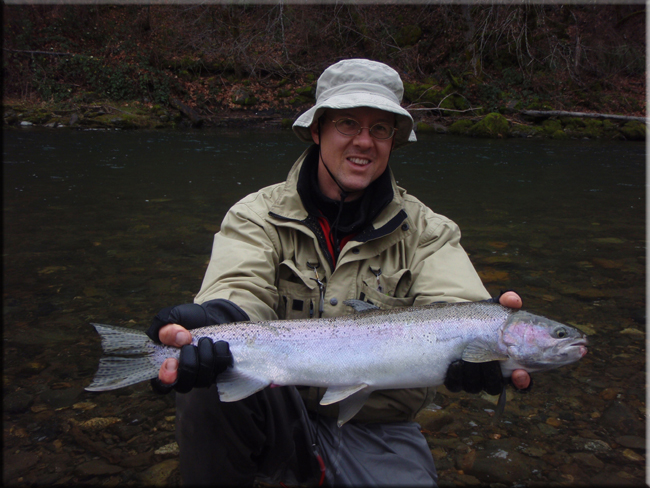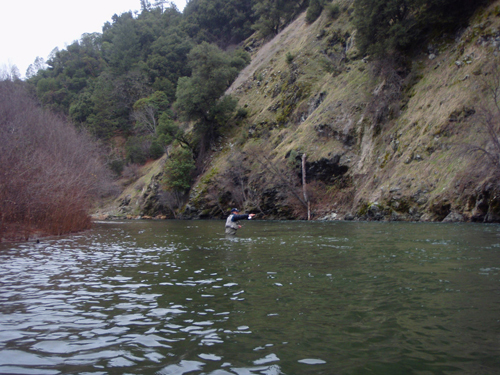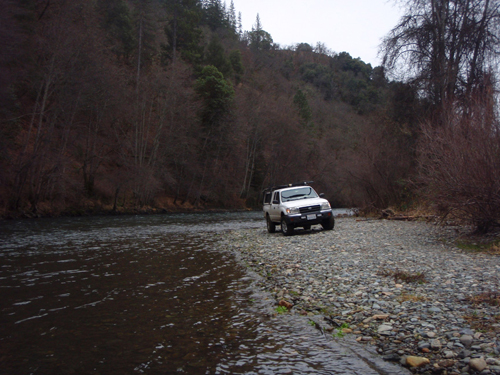










I've fished the Trinity River ii Northern CA several times over the past decade and it has always struck me with its quiet beauty. Green hills roll out from the river banks toward the Trinity Alps and the prospect of gold still hangs in the air. Beyond that, fishing and outdoor recreation are the main draws for a quaint tourism industry. As a result, the Trinity seems to be better managed than some of the other North Coast Rivers suffering from the strains of uncontrolled pressure. Recent years have seen fish numbers reaching their historic highs with catches topping 20 fish per day!
Wild and hatchery salmon and steelhead make their way up the Trinity from the Klamath in several runs starting with the Spring Chinooks around mid-June. This is followed by waves of fall run Cohos and Kings, and continues with steelies rolling in (and out) thru March.

Any steelheader will tell you that rainfall is the main factor affecting runs of fish from the ocean into rivers. Timing is next. Being on the river after a good rain, when the water is falling and clearing dramatically increases your chances at hooking an ocean-run fish. The Trinity is a tailwater, so that makes for more predictable water conditions year-round. Like all rivers, there are several tributaries feeding in along the way that can muddy things up. When that happens, heading upstream will often provide viable places to toss a line. Basically, there's a lot of good-lookin' water to work here.
There are dispersed sections of private property lining the banks, so a drift boat offers a great way to access this water. This river does demand good rowing skills however. The water levels released from the dam at Lake Lewiston can often expose rocks that require careful navigation. Even the best river rats are likely to scrape a few...
For walking anglers, the Trinity does offer quite a bit of access, I should add that it�s wise to pay attention to where the tribal lands begin and respect that territory. There is a fly shop near the Bucktail area, and maps that provide useful information for the wandering fisherman. Aside from good exercise, walking and wading forces you to slow down and really focus on the presentation. With all the modern impetus in Life to go faster, faster (faster!), slowing down is perhaps one of the greater benefits of fishing in the first place.

As usual, if you're willing to trek around a bit, you can find a good deal of solitude on some epic runs and holes. Those places are nearly always holding some fish, and having the place to yourself allows for more experimentation until that magic combination is struck. Golden stones weighted on a lo-ong leader seemed to be the ticket on this trip. The water this time (January) was higher and colder than normal, and the fish a bit slower to move. Even if the fish are only mildly cooperative, steelheading retains its charm. A bonus brown even came out of the woodwork. Oh yes, and there are some big ones in here...
Camp is made wherever the fishing looks promising (always!). Although I find tent-life quite inviting, during the winter it is often raining making for a soggy return. And when a hot shower and a bed are reasonably available, it's greatly appreciated after a long day of hiking and fishing a cold river. Weaverville is a centrally-located choice for good food and lodging options. The 49'er is clean and comfortable, and the Grange has excellent buffalo burgers that go well with a pint of North Coast goodness! Indian Creek Lodge in Douglas City is close to a lot of great fishing spots within walking distance, and I stayed there before it was renovated. It was fine then, and I've heard the upgraded model is quite nice.
When's the best time to hit the Trinity? Nearly anytime you can be there.
BACK to Articles of Fact & Fiction
Contact Write Angler to help fill your creel!
